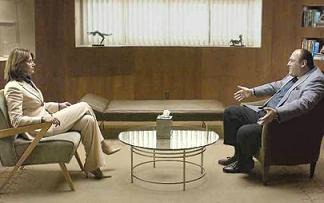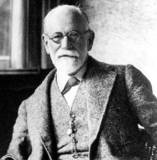About Counseling
Hollywood Movies and Myths

|
Do these people look familiar? For decades, the movies and literature have entertained us with the personalities of therapists and clients, and enthralled us with portrayals of private sessions. Early historical therapists are (left to right) the eccentric Sigmund Freud and mysterious Carl Jung. While more recently we have popular TV therapists, such as"Soprano's" Jennifer Melfi and reality TV's "Celebrity Rehab with Dr. Drew." Dr. Laura, and Dr. Phil are other popular radio and TV personalities. |
|
 Woody Allen, award winning film director, comedian, playwright and musician openly says he's an enthusiastic fan of therapy, and the subject often appears in his movies. |
Famous therapy clients are actor and movie director Woody Allen (left), character Tony Soprano (below).  |
 |
Therapy, relationship counseling, and rehabilitation have become entertaining and trendy for sure. Do we get something by watching others (either fictional or real) go through some of the challenges we all share? I think storytelling, at its best, does just that. However, literature and media often portray events dramatically or artistically, rather than accurately, to inspire certain emotional or thinking states, and for entertainment. |
Read below for some myth-busting information about counseling.
Myth: Only rich people see therapists.
Truth: The stereotype of the rich New York City socialite who sees her therapist every week and brings Fluffy the poodle, is just that - a stereotype.
Therapists see clients with diverse lifestyles, cultural backgrounds, economic levels, and religious/political affiliations.
In case you are not a rich socialite (and even if you are), there are ways that you can make seeing a therapist more financially affordable. See my FAQs page for ideas.
Myth: Therapy is "head shrinking."
Truth: Your head will be the same size, but your problems could shrink as you gain awareness, clarity, education, understanding and skills related to the issue that brought you in. As you read more about counseling, and perhaps experience it yourself from a licensed, board certified therapist (like me), you'll find that the methods and the process are explainable and can be readily understood. This is a collaborative process, and you have the right to know what's happening, and a voice in how counseling unfolds.
Myth: People should see a therapist only if things get really bad.
Truth: Folks see a therapist for a wide range of problems. For example, seeing a therapist for life coaching can help you to set and attain your important personal, healthy lifestyle, and career goals.
Or maybe you recognize that you have a short term issue such as getting over a dating relationship breakup, that you could get through more easily with the help of a wise and compassionate therapist.
Or maybe your doctor just recommended that you start a diet and exercise plan, but you have a hard time starting, or sticking to it.
Perhaps you and a loved one are experiencing overwhelming feelings and behaviors that would be easier with professional guidance.
Regular or occasional visits to a therapist can part of a healthy lifestyle, like going to a financial advisor for understanding on money matters, or a mechanic to keep your car in good condition.
Life is full of challenges. Why not get help immediately? You don't need to suffer needlessly.
Myth: Going to therapy is a sign of giving up.
Truth: Determining to use any and all available resources to solve problems, alleviate pain, and increase health and happiness is a sign of real strength and courage.
Therapy can be a gift to yourself and your loved ones.
Myth: It takes years to get results.
Truth: How long a client engages in therapy usually depends on the issue and the client's financial resources.
Benefits from therapy can happen as soon as the first session and the more and longer you go the more helpful it can be.
It is the general case that the longer one engages in therapy the richer the therapeutic relationship as familiarity and trust continue to develop over time.
However, it should not take long to determine if you are benefiting from therapy with a particular therapist, perhaps two to four sessions. In most cases, significant improvement can be obtained in 2-20 sessions.
Evaluating the benefits you are receiving from therapy, and making changes as necessary, is a regular part of the therapy process.
Myth: Therapists just listen.
Truth: Well, it's true that therapists do listen carefully (and need to be very good at it). They can also be quite active.
For example, depending on the the problem and what suits the client, during the course of treatment I may educate my client about counseling as a process, or about an issue in general, check in between sessions, keep us updated on current research, provide in session or between session assignment, help my client practice new skills, give community resources, and collaborate with family members, doctors, nutritionists, psychiatrists and other health care providers if needed.
Myth: Counseling is just advice.
Truth: The goal of therapy is to help you solve and cope with the challenging problems that brought you in. This likely takes more than simple advice, or you would have done it already. My goal is also to also help you know a little more about counseling and how it helps.
You may have already received, and even acted on, advice from well-meaning friends, family, and even books. Yet the problem persists. It may be time to team up with a professional therapist.



